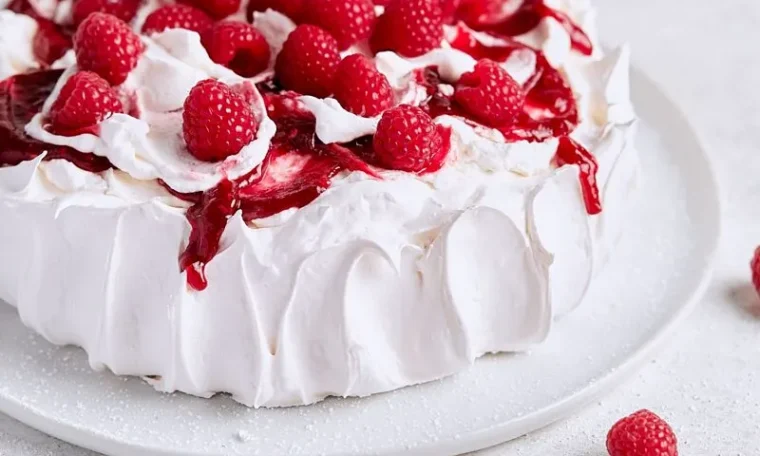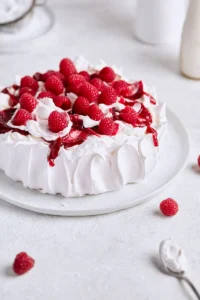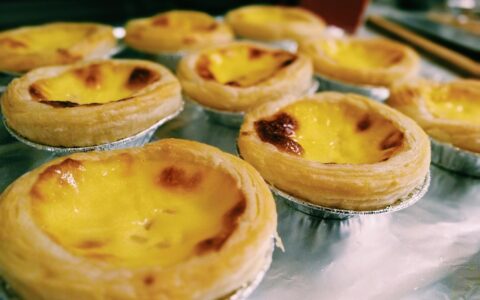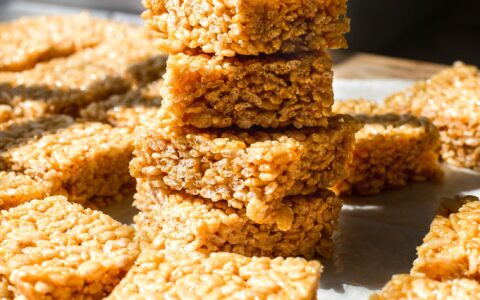
Win Your Next Pageant
Get Pageant Questions Written By A Miss Universe Judge

The Art of Pavlova: A Complete Guide to the Perfect Dessert
Introduction
Few desserts embody elegance and simplicity quite like pavlova. With its crisp, marshmallow-like shell, pillowy soft interior, and crown of whipped cream and fresh fruit, this iconic dessert is a celebration of texture and flavor. Named after the Russian ballerina Anna Pavlova during her 1920s tour of Australia and New Zealand (both countries passionately claim its origin), this meringue-based dessert has become a staple at celebrations worldwide.
A Dessert Steeped in History and Debate
The pavlova’s origins are as dramatic as the ballet performances that inspired it:
- 1920s: Created in honor of Anna Pavlova’s ethereal grace, resembling her tutu.
- Australia vs. New Zealand: Both nations fiercely debate its true origin, with recipes appearing in each country by the 1930s.
- Global Appeal: Today, it’s beloved for its contrast of crisp meringue and soft filling, often served at Christmas and summer gatherings.
What makes pavlova so special is its delicate balance—a dessert that seems sophisticated yet is surprisingly simple to make, provided you understand its unique chemistry.
Why Pavlova Stands Apart
This dessert captivates because of its:
- Textural Contrast: A shatteringly crisp shell gives way to a soft, marshmallow-like center.
- Visual Drama: A snowy-white base topped with vibrant fruit makes it a showstopper.
- Versatility: Adapts to any season—berries in summer, citrus in winter.
- Make-Ahead Ease: The meringue can be baked days in advance.
The Science Behind the Perfect Pavlova
Mastering pavlova requires precision:
1. Meringue Stability
- Room-temperature egg whites whip to greater volume.
- Sugar addition must be gradual to dissolve completely.
- Acid (vinegar/lemon juice) strengthens the protein structure.
2. Baking Low and Slow
- Low temperature (250°F/120°C) prevents cracking and ensures a dry shell.
- Cooling in the oven prevents sudden collapse from temperature shock.
3. Topping Balance
- Whipped cream should be lightly sweetened to complement (not overpower) the meringue.
- Fruit acidity (like passionfruit or berries) cuts through the sweetness.
Why This Recipe Works
After testing dozens of versions, this recipe delivers because it:
✔ Uses superfine sugar for smoother meringue.
✔ Includes cornstarch for stability.
✔ Provides foolproof baking and cooling instructions.
✔ Offers troubleshooting tips for common issues (cracking, weeping).
Global Variations to Explore
While the classic pavlova reigns supreme, creative twists include:
- Tropical: Mango, coconut, and lime.
- Berry Medley: Strawberries, raspberries, and blueberries.
- Chocolate: Cocoa powder in the meringue + chocolate shavings.
- Vegan: Aquafaba (chickpea brine) instead of egg whites.
Now, let’s create this edible masterpiece. ownthatcrown.com
Classic Pavlova Recipe
Essential Equipment
- Stand mixer or hand mixer
- Baking sheet
- Parchment paper or silicone mat
- Fine-mesh sieve
- Spatula
- Cooling rack
_______________________________________________________________________________
Ingredients
(Serves 6-8)
Meringue Base
- 4 large egg whites, room temperature
- 1 cup (200g) superfine sugar (or pulse granulated sugar in a blender)
- 1 tsp white vinegar or lemon juice
- 1 tsp cornstarch
- 1 tsp vanilla extract
Toppings
- 1 cup (240ml) heavy cream, chilled
- 2 tbsp powdered sugar
- 1 tsp vanilla extract
- 2 cups mixed fresh fruit (berries, kiwi, passionfruit, etc.)
- Mint leaves for garnish (optional)
Step-by-Step Instructions
1. Prepare the Meringue
- Preheat oven to 250°F (120°C). Line a baking sheet with parchment.
- Beat egg whites on medium speed until soft peaks form.
- Gradually add sugar, 1 tbsp at a time, until stiff, glossy peaks form.
- Gently fold in vinegar, cornstarch, and vanilla.
2. Shape and Bake
- Spoon meringue onto parchment, forming a 8-inch circle with slightly raised edges.
- Bake 1 hour, then turn off oven and let cool inside for 2 hours (do not open the door!).
3. Add Toppings
- Whip cream with powdered sugar and vanilla to soft peaks.
- Spread over cooled meringue; top with fruit and garnish.
Expert Tips
- No cracks: Avoid overbeating egg whites.
- Sticky meringue? Bake longer at low heat.
- Storage: Keep unfilled meringue in an airtight container for 3 days.
Creative Variations
- Lemon Curd: Swirl into whipped cream.
- Eton Mess: Crumble meringue with cream and raspberries.
- Peppermint: Add crushed candy canes for the holidays.
Why Pavlova is Timeless
This dessert’s magic lies in its contrasts—crisp yet soft, sweet yet tart, elegant yet simple. Whether served at a summer picnic or a winter feast, it’s a celebration of texture and taste.
Pro Tip: For extra drama, drizzle with raspberry coulis or melted chocolate.






